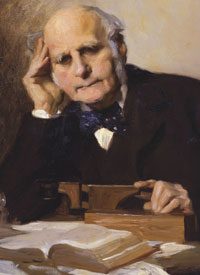
The year is 1941, and the Nazis are in the midst of their Lebensborn program. Men of pure Aryan stock — especially members of the Waffen-SS, thought the cream of the crop — have a special purpose. In many occupied countries, they are encouraged to mate with blonde-haired, blue-eyed women — those reflecting the very picture of the Aryan ideal themselves. And “mate” is the word; romance is not necessary here, nor marriage, nor moral constraints. For the program is to serve as a baby factory that will produce future Aryan supermen for the Third Reich.
Lebensborn grows out of what is central to the Nazi philosophy: eugenics, which is the improvement of the human race through the process of selective breeding. And the Nazis embrace it for a very interesting reason: They have a penchant for indulging ancient myths, and one of these is that they are descended from a race of Aryan supermen who lost their superhuman capabilities because they procreated with inferior races, thus visiting upon themselves a kind of biological devolution. And they aim to reverse the process by jump-starting and accelerating evolution in a sort of hothouse environment.
Of course, talk of breeding supermen based upon an ancient template sounds kooky; speaking of inferior races disgusts the modern palate; and “eugenics,” now joined at the hip with the Nazis, has become a dirty word. Yet it is not at all accurate to say that the Nazis created eugenics. It is more correct to say that eugenics created the Nazis.
Eugenics, at least in a more primitive form, dates back to the time of the Greek philosopher Plato, who, inspired by the Spartans, advocated murdering “weak” children. It wasn’t until 1883 and the theory of evolution’s ascendancy, however, that the word “eugenics” was coined by English scientist Francis Galton, a cousin of Charles Darwin. It was at this time that the field was catching on like wildfire, and it would gain increasing acceptance during the next few decades. For, while it may be hard to believe today, eugenics was considered to be Science with a capital “S,” a “thinking man’s” philosophy, the politically correct theory of the age, only finding opposition from those shackled by faith and fancy. And although German Nazis made it infamous, in the United States in the early 20th Century, it was downright popular.
Eugenics Breeding Grounds
Helped by well-heeled benefactors such as the Carnegie Institution, the Rockefeller Foundation, and the Harriman railroad fortune, the eugenics movement was already roaring in the Roaring ’20s. And it sometimes manifested itself in relatively innocuous ways. For instance, writes Carol Squiers in Perfecting Mankind: Eugenics and Photography:
“Fitter Families” contests were staged at state agricultural fairs throughout the U.S. in the 1920s. They judged the eugenic worth of local families. Mary T. Watts, the co-organizer of the first contest at the 1920 Kansas Free Fair, explained that when anyone inquired what the contests were, “we say, ‘while the stock judges are testing the Holsteins, Jerseys, and whitefaces in the stock pavilion, we are judging the Joneses, Smiths & the Johns.’” The American Eugenics Society supported the contests, which grew out of a “Better Baby” competition at the 1911 Iowa State Fair. The family contests were featured at seven to ten fairs yearly and were held in the “human stock” sections.
As is always the case when man is reduced to animal, however, the eugenic mindset inspired darker actions as well. Edwin Black treated this subject in The Horrifying American Roots of Nazi Eugenics, writing:
Elements of the [eugenics] philosophy were enshrined as national policy by forced sterilization and segregation laws, as well as marriage restrictions, enacted in twenty-seven states. In 1909, California became the third state to adopt such laws. Ultimately, eugenics practitioners coercively sterilized some 60,000 Americans, barred the marriage of thousands, forcibly segregated thousands in “colonies,” and persecuted untold numbers in ways we are just learning. Before World War II, nearly half of coercive sterilizations were done in California, and even after the war, the state accounted for a third of all such surgeries.
… Much of the spiritual guidance and political agitation for the American eugenics movement came from California’s quasi-autonomous eugenic societies, such as the Pasadena-based Human Betterment Foundation and the California branch of the American Eugenics Society, which coordinated much of their activity with the Eugenics Research Society in Long Island. These organizations — which functioned as part of a closely-knit network — published racist eugenic newsletters and pseudoscientific journals, such as Eugenical News and Eugenics, and propagandized for the Nazis.
Yet it would be a mistake to place the United States in the same league as Nazi Germany; rather, it’s more correct to say that many Germans embraced the same fallacy as most of the secular world. For eugenics’ popularity knew few borders. Sure, while Theodore Roosevelt, Oliver Wendell Holmes, the National Academy of Sciences, and the National Research Council were supporters, eugenic policies were instituted in Australia, Japan, Canada, China, Sweden, France, and many other nations as well. In fact, among its most prominent advocates were two foreigners: famed English writers H.G. Wells and George Bernard Shaw.
For example, we could note that The Time Machine, perhaps Wells’s most famous work, has a eugenicist message. Yet we need not interpret symbolism to understand his position on the matter, as he said quite explicitly, “This thing, this euthanasia of the weak and sensual, is possible. On the principles that will probably animate the predominant classes of the new time, it will be permissible, and I have little or no doubt that in the future it will be planned and achieved.” As for Shaw, he echoed these sentiments, saying, “A part of eugenic politics would finally land us in an extensive use of the lethal chamber. A great many people would have to be put out of existence simply because it wastes other people’s time to look after them.”
Yet, in the early 20th Century, the United States was a burgeoning power, and as such, it was often at the forefront of the sciences. And eugenics was no exception. In fact, many German eugenicists looked to America’s policies as a model; Hitler himself said to a fellow Nazi that he had “studied with interest the laws of several American states concerning prevention of reproduction by people whose progeny would, in all probability, be of no value or be injurious to the racial stock.” And, truth be known, the spoiled fruits of eugenics still plague America to this day.
Spoiled Fruits of a Movement
One of these would be the Planned Parenthood organization. While many are unaware of the fact, the organization’s founder, Margaret Sanger, was a eugenicist with some particularly odious views. For example, in her work Women and the New Race, she wrote, “The most merciful thing that a large family does to one of its infant members is to kill it.” And this culture-of-death spirit certainly lives on. Planned Parenthood affiliates perform more than 300,000 abortions a year, turning a profit of more than $100 million and collecting more than $300 million of your tax money in the process. Sanger also expressed Nazi-like views long before the National Socialists took power. For example, in her 1922 book,The Pivot of Civilization, she wrote, “Every single case of inherited defect, every malformed child, every congenitally tainted human being brought into this world is of infinite importance to that poor individual; but it is of scarcely less importance to the rest of us and to all of our children who must pay in one way or another for these biological and racial mistakes.” (Emphasis added.)
Perhaps it is passions such as the above that inspired Sanger to create the “Negro Project,” an organized campaign to limit — and some say exterminate — America’s black population. Black author Tanya L. Green sheds some more light on Sanger’s motivations in her piece “The Negro Project: Margaret Sanger’s Eugenic Plan for Black Americans,” writing:
Margaret Sanger aligned herself with the eugenicists whose ideology prevailed in the early 20th century. Eugenicists strongly espoused racial supremacy and “purity,” particularly of the “Aryan” race. Eugenicists hoped to purify the bloodlines and improve the race by encouraging the “fit” to reproduce and the “unfit” to restrict their reproduction. They sought to contain the “inferior” races through segregation, sterilization, birth control and abortion.
It is easy for pro-life people, such as I, to look askance at the Margaret Sangers of the world, just as it is easy for anti-American bigots to place the onus on America, or blacks to place it on whites. While there certainly are villains in this story, however, it is more important to expose destructive ideas than deluded people. After all, ideas live on long after idealists pass on.
Certainly, the desire to have strong, vibrant citizens and children is nothing new. The aforementioned Spartans would kill a male infant if he was perceived to have any defect whatsoever, and parents typically hope and pray for healthy, intelligent, and strong sons and daughters. And, of course, an offspring’s characteristics can most assuredly be influenced through selective breeding. For example, consider the dogs we have as pets today. The breeds many of us know and love — the Rottweiler, cocker spaniel, Neapolitan Mastiff, etc. — never existed until they were bred by man. Their unique characteristics are the result of taking a group of canines, breeding the ones that exhibit desired traits, and killing those that do not. And repeating this process generation after generation yielded unique beasts ideally suited to whatever purpose they were to be used for.
And this is the problem with eugenics. We must not “use” people or view them as objects that serve a “purpose.” Yet why does the science endeavor to create a better human? It is for that very reason: so that they will serve the purpose of being better soldiers, citizens, scientists, producers, etc. But, then, what happens once you’ve reduced people to objects, to cogs in the machinery of the state? Well, when it seems that a baby will be insufficient for his purpose, you give him the Spartan treatment; and when a cog gets too old to serve its purpose, you euthanize it — for the good of society. And you then have embraced the eugenicist position that there are “human beings who never should have been born,” as Sanger said; or that there is “life unworthy of life,” as the Nazis said. The point here is that you don’t value people based on what they can do. You value them based on what they are.
Yet this brings us to a very interesting question: What are they? And is it just a coincidence that eugenics took hold in the wake of evolution’s acceptance? Is it possible that classical evolution’s conception of “what they are” engenders a eugenicist mindset? Let us examine the matter.
Evolution’s Ties to Eugenics
Traditional Christianity and classical evolution involve very different conceptions of man’s nature. Christianity teaches that man is the culmination of God’s creation, His sixth-day triumph. Man is not merely a steppingstone on the way to some superior being but a finished product. Sure, he is fallen as well as finished and needs to be perfected, but this is not a matter of improving the flesh but of transcending it. And this is done with knowledge of what is good and the gift of God’s grace. Moreover, even if the flesh is broken, hampered by crippling limitation, the person’s soul bears the beauty of the Ultimate Beholder. The person is valuable not because of what he can do but because of what he is: a child of God with a soul from Heaven.
In contrast, evolution tells us that we are just one stage in a long line of creatures experiencing change in a process that is often, amusingly, called improvement, even though we’re moving toward we don’t know what without knowing why. But evolutionists take it as doctrine that it is improvement, and all people want to improve the human condition. For Christians, this means spreading the faith; for evolutionists, it means improving the genes. Ergo, eugenics.
Of course, many evolutionists will protest, saying that they find eugenics abhorrent. Yet the link between evolution and eugenics is undeniable, as it was made by none other than Sir Francis Galton himself. Galton developed his eugenic principles only after reading his cousin Charles Darwin’s work The Origin of Species, which inspired him to build on Darwin’s work. And this should surprise no one. Sure, today eugenics is thought ill-considered, but it is not illogical. If evolution is improvement and improvement is good, and if the good of the many outweighs the good of the few, it makes sense to facilitate evolution. And because it is logical, at least on the surface, it is necessary to look a little deeper.
Eugenics is an outgrowth of classical evolution, which presupposes that we are a cosmic accident and thus implies atheism. The problem with this worldview is that it makes many assumptions, fails to ask the most basic questions, and then contradicts itself. For one thing, if there is no God, no Truth — no standard for determining good that transcends man — on what basis can we determine what constitutes improvement? Why is it better for man to survive and “evolve” than to perish? After all, ask some of the nature-worshipping misanthropes amongst us, and they will tell you that the world would be better off if mankind disappeared entirely.
Yet, even if you accept — based on consensus opinion and nothing more — that what evolutionists say is improvement is indeed improvement, what purpose does it serve? To illustrate this point, I’ll use a variation on a criticism G.K. Chesterton made of H.G. Wells when the latter suggested that the purpose of life was to beget children. It is as if you asked, “What is the use of hammers?” and the answer was, “To create better hammers.” And then you asked, “And what is the use of those hammers?” and the answer was “To create better hammers still.” It doesn’t answer the most basic questions: “Why create hammers in the first place” and “What is the good of having hammers?” The eugenicist philosophy not only reduces man to animal, it reduces man’s existence to meaninglessness. The Christian knows that he is trying to improve — which he calls growing in holiness — so he can spend eternity with God. The atheist may try to improve, and he may actually succeed. But if his worldview were correct, it would mean that he would spend eternity as dust, indistinguishable from a “defective” some eugenicist might have wanted to exterminate.
Of course, if atheists were right, dust is essentially all we would be, some pounds of chemicals and water. We would merely be organic robots — tools, much like a hammer. And, then, why trouble over how we manipulate these automatons’ circuitry? And what could be wrong with terminating the function of robots that cannot serve their “purpose”? Besides, without Truth and thus without objective right and wrong, nothing could be “wrong” in any real sense, anyway.
Why does this philosophy matter? It’s not because eugenics will rear its ugly head once again, because eugenics, strictly speaking, will not. But it has not been trumped by morality, only technology. With genetic engineering, we no longer have to select people for breeding; we can now select the genes themselves. This science holds the promise of eliminating birth defects, but it can also be misused. It finally gives modern-day utopians a tool with which they can create supermen, Aryan or otherwise, in a laboratory. And unless we want to end up as test subjects, we had better realize that man’s value lies not in his ability to become or create a superman, but in being born of the supernatural and possessed of the eternal.
Photo: Sir Francis Galton, who coined the term "eugenics"



